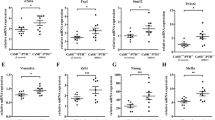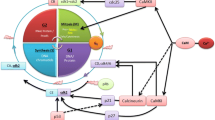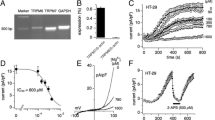Abstract
The gastrointestinal (GI) tract handles a complex task of nutrient absorption and excretion of excess fluid, electrolytes, and toxic substances. GI epithelium is under constant proliferation and renewal. Differentiation of colonocytes occurs as they migrate from the basal layer to the apex of the crypt. Cells of the basal layer are highly proliferative but less differentiated, whereas apical cells are highly differentiated but non-proliferative. Alterations of this intricate process lead to abnormal proliferation and differentiation of colorectal mucosa leading to development of polyps and neoplasia. The effects of calcium (Ca) on colorectal mucosal growth have been extensively studied after the discovery of the calcium sensing receptor (CaSR). Fluctuation in extracellular Ca can induce hyperproliferation or quiescence. Disruption in the function of CaSR and/or changes in the level of CaSR expression can cause loss of growth suppressing effects of extracellular Ca. This review addresses the role of Ca and CaSR in the physiology and pathophysiology of colonocyte proliferation.



Similar content being viewed by others
Abbreviations
- GI:
-
Gastrointestinal
- Ca:
-
Calcium
- CaSR:
-
Calcium sensing receptor
- ATP:
-
Adenosine triphosphate
- GPCR:
-
G-protein coupled receptor
- MAPK:
-
Mitogen-activated protein kinase
- APC:
-
Adenomatous polyposis coli
- TA:
-
Transit amplifying
- DNA:
-
Deoxyribonucleic acid
- HMG:
-
High mobility group
- TCF:
-
T-cell factor
- PKC:
-
Protein kinase
- GSK:
-
Glycogen synthase kinase
- VDR:
-
Vitamin D receptor
- SC:
-
Stem cell
- NSC:
-
Non-stem cell
- SI:
-
Sucrase isomaltase
References
Feldman M, Frideman LS, Brandt LJ. Minerals. In: Sleisenger and Fordtran’s Gastrointestinal and Liver diseases. Vol 1. 8th ed. Saunders; 2006: 2177–2178.
Halstead CH, Levine MA, Lonnerdal BL et al. Vitamins and minerals. In: Textbook of Gastroenterology. Vol 1, 5th ed. Oxford: Blackwell; 2009:494–496.
Brown EM, MacLeod RJ. Extracellular calcium sensing and extracellular calcium signaling. Physiol Rev. 2001;81:239–297.
Saidak Z, Mentaverri R, Brown EM. The role of calcium sensing receptor in the development and progression of cancer. Endocr Rev. 2009;30(2):178–195.
Whitfield JF. Calcium, calcium-sensing receptor and colon cancer. Cancer Lett. 2009;275:9–16.
Whitfield JF, Bird RP, Chakravarthy B, Isaacs RJ et al. Calcium: Cell cycle regulator, differentiator, killer, chemopreventor, and maybe, tumor promoter. J Cell Biochem. 1995; (Suppl. 22):74–91.
Clevers H. Wnt/β-catenin signaling in development and disease. Cell. 2006; (127):469–480.
Gregorieff A, Pinto D, Begthel H, et al. Expression pattern of Wnt signaling components in the adult intestine. Gastroenterology. 2005;129:626–638.
Pinto D, Clevers H. Wnt control of stem cells and differentiation in the intestinal epithelium. Exp Cell Res. 2007;306:357–363.
Su LK, Vogelstein B, Kinzler KW. Association of the APC tumor suppressor proteins with catenins. Science. 1993;262:1734–1737.
Nathke I. The adenomatous polyposis coli protein: the Achilles heel of the gut epithelium. Annu Rev Cell Dev Biol. 2004;20:337–366.
Tian JQ, Quaroni A. Involvement of p21 (WAF/CIP1) and p27 (Kip1) in intestinal epithelial cell differentiation. Am J Physiol. 1999;276:C1245–C1258.
Chakrabarty S, Wang H, Canaff L, et al. Calcium sensing receptor in human colon carcinoma: interaction with Ca2+ and 1,25-Dihydroxyvitamin D3. Cancer Res. 2005;65(2):493–498.
Brenner BM, Russell N, Albrecht S, et al. The effect of dietary vitamin D3 on the intracellular calcium gradient in mammalian colonic crypts. Cancer Lett. 1998;127:43–53.
Chakrabarty S, Radjendirane V, Appelman H, et al. Extracellular calcium and calcium sensing receptor function in human colon carcinomas: promotion of E-cadherin expression and suppression of β-catenin-TCF activation. Cancer Res. 2003;63:67–71.
Birchmeier W, Behrens J. Cadherin expression in carcinomas: role in the formation of cell junctions and the prevention of invasiveness. Biochim Biophys Acta. 1994;1198:11–26.
Birchmeier W. E-cadherin as a tumor (invasion) suppressor gene. Bioessays. 1995;17:97–99.
Oka H, Shiozaki H, Kobayashi K, et al. Expression of E-cadherin cell adhesion molecules in human breast cancer tissues and its relationship to metastasis. Cancer Res. 1993;53:1696–1701.
Pignatelli M, Ansari TW, Gunter P, et al. Loss of membranous E-cadherin expression in pancreatic cancer: correlation with lymph node metastasis, high grade, and advanced stage. J Pathol. 1994;174:243–248.
Bhagavathula N, Kelley EA, Reddy M, et al. Upregulation of calcium-sensing receptor and mitogen-activated protein kinase signaling in the regulation of growth and differentiation in colon carcinoma. Br J Cancer. 2005;93:1364–1371.
Morin PJ. β-catenin signaling and cancer. Bioessays. 1999;21:1021–1030.
Fagotto F, Funayama N, Gluck U, et al. Binding to cadherins antagonizes the signaling activity of β-catenin during axis formation in Xenopus. J Cell Biol. 1996;132:1105–1114.
Wong NA, Pignatelli M. β-catenin—a linchpin in colorectal carcinogenesis? Am J Pathol. 2002;160:389–401.
Bhagvathula N, Hanosh AW, Nerusu KC, et al. Regulation of E-cadherin and β-catenin by Ca2+ in colon carcinoma is dependent on calcium-sensing receptor expression and function. Int J Cancer. 2007;121:1455–1462.
Scaglione-Sewell B, Abraham C, Bissonnette M, et al. Decreased PKC-α expression increases cellular proliferation, decreases differentiation, and enhances the transformed phenotype of CaCo-2 cells. Cancer Res. 1998;58:1074–1081.
Guillem JG, O’Brian CA, Fitzer CJ, et al. Studies on protein kinase C and colon carcinogenesis. Arch Surg. 1987;122:1475–1478.
Peterlink M, Grant WB, Cross HS, et al. Calcium, vitamin D and cancer. Anticancer Res. 2009;29:3687–3698.
Cross HS, Pavelka M, Slavik J, et al. Growth control of human colon cancer cells by vitamin D and calcium in vitro. J Natl Cancer Inst. 1992;84:1355–1357.
Cross HS, Hulla W, Tong WM, et al. Growth regulation of human colon adenocarcinoma-derived cells by calcium, vitamin D and epidermal growth factor. J Nutr. 1995;125:2004S–2008S.
Hulla W, Kallay E, Krugluger W, et al. Growth control of human colon-adenocarcinoma-derived Caco-2 cells by vitamin-D compounds and extracellular calcium in vitro: relation to c-myc oncogene and vitamin D receptor expression. Int J Cancer. 1995;62:711–716.
Tong WM, Hofer H, Ellinger A, et al. Mechanism of antimitogenic action of vitamin D in human colon carcinoma cells: relevance for suppression of epidermal growth factor-stimulated cell growth. Oncol Res. 1999;11:77–84.
Hoenderop JGJ, Nilius B, Bindels RJM. Calcium absorption across epithelia. Physiol Rev. 2004;85:373–422.
Renehan AG, O’Dwyer ST, Haboubi NJ, et al. Early events in colorectal carcinogenesis. Colorectal Dis. 2002;4:76–89.
Aoki K, Taketo MM. Adenomatous polyposis coli (APC): a multifunctional tumor suppressor gene. J Cell Sci. 2007;120:3327–3335.
Senda T, Shimomura A, Iizuka-Kogo A. Adenomatosis polyposis coli (Apc) tumor suppressor gene as a multifunctional gene. Anat Sci Int. 2005;80:121–131.
Deng G, Song A, Pong E, et al. Promoter methylation inhibits APC gene expression by causing changes in chromatin conformation and interfering with the binding of transcription factor CCAAT-binding factor. Cancer Res. 2004;64:2692–2698.
Smith KJ, Johnson KA, Bryan TA, et al. The APC gene product in normal and tumor cells. Proc Natl Acad Sci USA. 1993;90:2846–2850.
Boquoi A, Enders GH. Adenomatous polyposis coli mutations in colon cancer-slipping off the brake and onto the gas pedal. Cancer Biol Ther. 2008;7:485–487.
Huncharek M, Muscat J, Kupelnick B. Colorectal cancer risk and dietary intake of calcium, vitamin D, and dairy products: a meta-analysis of 26, 335 cases from 60 observational studies. Nutr Cancer. 2009;61:47–69.
Shabahang M, Buras RR, Davoodi F, et al. 1, 25-Dihydroxyvitamin D3 receptor as a marker of human colon carcinoma cell line differentiation and growth inhibition. Cancer Res. 1993;53:3712–3718.
Evans SR, Nolla J, Hanfelt J, et al. Vitamin D receptor expression as a predictive marker of biological behavior in human colorectal cancer. Clin Cancer Res. 1998;4:1591–1595.
Vandewalle B, Adenis A, Hornez L, et al. 1, 25-Dihydroxyvitamin D3 receptors in normal and malignant human colorectal tissues. Cancer Lett. 1994;86:67–73.
Canaff L, Hendy GN. Human calcium-sensing receptor gene. Vitamin D response elements in promoters P1 and P2 confer transcriptional responsiveness to 1, 25-Dihydroxyvitamin D. J Biol Chem. 2002;277:30337–30350.
Palmer HG, Gonzalez-Sancho J, Espada J, et al. Vitamin D(3) promotes the differentiation of colon carcinoma cells by the induction of E-cadherin and the inhibition of β-catenin signaling. J Cell Biol. 2001;154:369–3870.
Cross HS, Nittke T, Peterlink M. Modulation of vitamin D synthesis and catabolism in colorectal mucosa: a new target for cancer prevention. Anticancer Res. 2009;29:3705–3712.
Bischoff-Ferrari HA, Giovannucci E, Willett WC, et al. Estimation of optimal serum concentrations of 25-hydroxyvitamin D for multiple health outcomes. Am J Clin Nutr. 2006;84:18–28.
Bacsi K, Hitre E, Kosa JP, et al. Effects of the lactase 13910C/T and calcium-sensor receptor A986S G/T gene polymorphisms on the incidence and recurrence of colorectal cancer in Hungarian population. BMC Cancer. 2008;8:317–324.
Jenab M, McKay J, Bueno-de-Mesquita HB, et al. Vitamin D receptor and calcium sensing receptor polymorphisms and the risk of colorectal cancer in European populations. Cancer Epidemiol Biomarkers Prev. 2009;18(9):2485–2491.
Pacheco II, MacLeod RJ. CaSR stimulates secretion of Wnt5a from colonic myofibroblasts to stimulate CDX2 and sucrase-isomaltase using Ror2 on intestinal epithelia. Am J Physiol Gastrointest Liver Physiol. 2008;295:748–759.
MacLeod RJ, Hayes M, Pacheco I. Wnt5a secretion stimulated by the extracellular calcium-sensing receptor inhibits defective Wnt signaling in colon cancer cells. Am J Physiol Gastrintest Liver Physiol. 2007;293:403–411.
Brown EM, Gamba G, Riccardi D, et al. Cloning and characterization of an extracellular Ca (2+)-sensing receptor from bovine parathyroid. Nature. 1993;366:575–580.
Harris DM, Go VLW. Vitamin D and colon carcinogenesis. J Nutr. 2004;134:3463S–3471S.
Conflict of interest statement
None.
Author information
Authors and Affiliations
Corresponding author
Rights and permissions
About this article
Cite this article
Ghevariya, V., Anand, S. A Short Primer on the Calcium Sensing Receptor: An Important Cog in the Colon Cancer Wheel?. Dig Dis Sci 56, 279–284 (2011). https://doi.org/10.1007/s10620-010-1295-1
Received:
Accepted:
Published:
Issue Date:
DOI: https://doi.org/10.1007/s10620-010-1295-1




